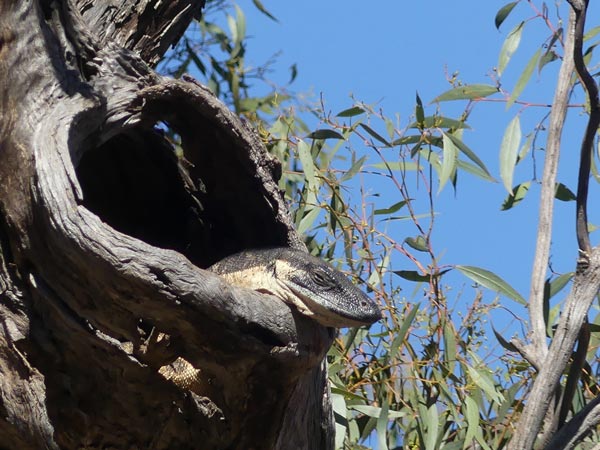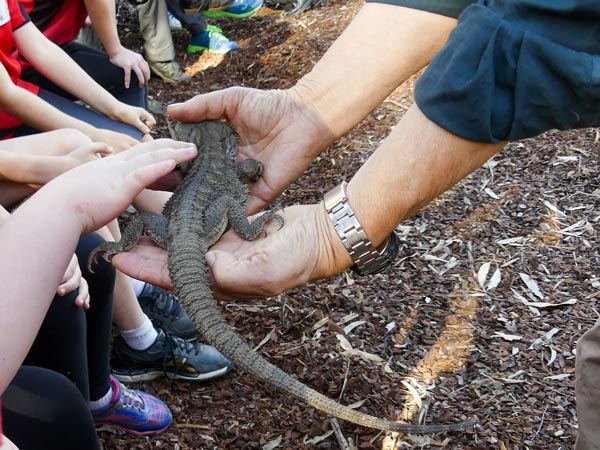Delights galore
/There was an unexpected observer at the junior landcare event at Galore Hill earlier this month. A large lace monitor was spotted in the hollow of a tree overlooking the picnic area and playground.
Early in the day it had just its head and one foot exposed, eyes often closed, basking in the autumn sun.
Photo: Sun-baking sleepy lace monitor, high in a tree, watching us below.
Photo: Lace monitors are also known as tree goannas
Photo: To give a sense of how high the monitor was, here's a wider shot of the whole tree. Monitor and hollow shown with arrow. Students and minibus below. John Holstein was the eagle-eye who first spotted our friend. See one of his fab photos here.
As the day progressed the monitor moved further out of the hollow, much to the delight of the students below. I wonder what it thought of all our activities!
Photo: 'Hanging out' for a bit more sun exposure
Photo: Still time for some more snoozing
The lace monitor was just one of many highlights of the day. And personally, I'm already planning more visits to Galore Hill. As the saying goes, I didn't know what I've been missing!
Where was this?
Galore Hill rises 215 metres above the surrounding plains, just north of Lockhart, NSW (about 1.5 hours drive from Albury). The 576 hectare Galore Hill Recreation Reserve is crown land that has been managed by Lockhart Shire since 1968. The shire and various local community groups have implemented a wide range of works over the decades, including extensive plantings and facilities for visitors.
With the students, we drove to the top of the hill and took a stroll to admire the views. From the lookout tower you can turn to take in all 360 degrees of views, including across to the Rock and along the Murrumbidgee river plains.
Photo: Students looking out from the lookout tower!
Photo: The view from 'ground level' next to the tower. [Kathie Le Busque took a photo of me taking this photo - see it on the Petaurus Facebook page].
Junior Landcare with school students
The activities of the day were held at the picnic area at the base of the hill which boasts playground, toilets, tables, shelter and BBQ (and bonus hollow-dwelling lace monitor!). Here the students from the attending schools rotated through multiple activities including reptile info and handling, Indigenous botanical art, bush treasure hunt and habitat exploration. The students enjoyed the various hands-on activities and the presenters also had a terrific time!
Photo: Students worked with Indigenous artist David Dunn on botanical art and learning about Indigenous culture.
Photo: The outdoor classroom - investigating nature's treasures and the many habitats the landscape provides.
Photo: Janet Wild shared insights into the lives of several local lizards, including this shingleback.
Photo: Students compared the feel, as well as the life histories, of the shingleback, this bearded dragon and a baby blue tongue lizard.
Flora
Within the site there are extensive plantings of native trees and shrubs, many planted in the 1970's. Species lists compiled over the years by various working groups and visitors (field naturalists, students and others) outline more than 800 flora species. There are extensive eucalypt, grevillea and acacia plantings, all of which are Australian, but many are from elsewhere around the country. An impressive 200 different plants are thought to be the only ones of their variety growing in Lockhart Shire. The 19 species of orchids on the lists also caught my eye!
Photo: One of several stunning flowering gums we came across ... identification is harder when not limited to local species!
Photo: These unusual buds were most helpful for identification (from the same plant as previous flowers). I think this is Coral Gum, Eucalyptus torquata, from Western Australia.
Insects
Although honey bee hives are not permitted in the reserve, we saw plenty of these bees attending flowers. It's likely unmanaged bees live there and possibly some were visiting from hives or wild colonies beyond the reserve.
Much to my delight we also spotted some Hylaeus native bees, some large flower wasps and a few beetles on the flowers. There were also many pupal cases of autumn rain moths, that had evidently been busy emerging in recent nights.
Photo: More interesting flowers ... and you'll have to take my word on the flower wasps, native bees and beetles, as I didn't get any great shots.
Photo: We spotted many of the tell-tale signs of recent moth emergence
Consider a visit
If you fancy a visit to Galore Hill (and I think you should), you can read up before you set out via the excellent brochure from Lockhart Shire. The reserve has good signage (with some of the same historical and nature notes) and the roads and facilities were in terrific shape for our visit.
If you need any further incentive, other attractions include caves that bushranger 'Mad Dog' Morgan is said to have used and a number of walking tracks. For those with nature observation interests, over 140 birds have been recorded visiting the reserve, and no doubt those seeking reptiles, mammals or invertebrates (for example) will also be well catered for. Riverina Local Land Services (LLS) recently coordinated a new biodiversity study for the site, so I'll be keen to check that out as well, once it's available to the public.
Thanks to everyone involved in organising and participating in this terrific day - the schools, Lockhart Shire, Eastern Riverina Landcare Group, Riverina LLS and, particularly, Petaurus Education Group for inviting me.
I look forward to more exploring at this special spot.








![Photo: The view from 'ground level' next to the tower. [Kathie Le Busque took a photo of me taking this photo - see it on the Petaurus Facebook page].](https://images.squarespace-cdn.com/content/v1/58bdf67d59cc6866d22123ec/1527410334273-990NF9WSGLBKFKUVLDEA/Galore-25.jpg)








